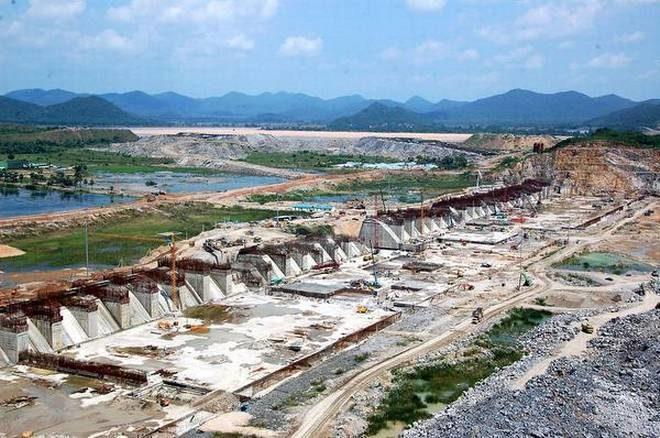Polavaram Politics: How the Project Became a Key Point for Politricking in Telugu States

Polavaram project is a multi-purpose irrigation project on the Godavari river in Andhra Pradesh. The aim is to provide water for irrigation, drinking, and industrial use, as well as generate hydroelectric power facilities to East Godavari, Vishakhapatnam, West Godavari and Krishna districts of Andhra Pradesh along with drought-proofing Rayalaseema region. The project has been accorded national project status by the Central Government of India in 2014 during the Telugu Desam Government.
Brief History
The project has a long history dating back to 1941, when the first proposal was made by Diwan Bahadur L. Venkatakrishna Iyer, then Chief Engineer in the Madras Presidency’s irrigation department. However, the project faced many delays and obstacles due to various reasons, such as lack of funds, inter-state disputes, environmental concerns, land acquisition issues, and design changes.
The project gained momentum after the bifurcation of Andhra Pradesh in 2014, when the new state government under N. Chandrababu Naidu vowed to complete it by 2019. The project was seen as a symbol of pride and development for the residual state of Andhra Pradesh. However, the project missed several deadlines and cost estimates escalated from Rs 16,000 crore in 2014 to Rs 58,000 crore in 2019.
Inter-state disputes & Political disputes
The project also faced opposition from the neighboring states of Telangana, Odisha, and Chhattisgarh, who claimed that the project would affect their water rights and submerge their lands. The Supreme Court and the National Green Tribunal also raised questions about the environmental and social impacts of the project.
In 2019, after the Telugu Desam Party (TDP) lost the state assembly elections to the YSR Congress Party (YSRCP), the project underwent another change of course. The new Chief Minister Y.S. Jagan Mohan Reddy ordered a review of the project contracts and alleged irregularities by the previous government. He also cancelled some of the contracts and invited fresh tenders for some components of the project. However, none of the allegations came true. As a result, the contracts were given to YSRCP aides.
The project has been facing many challenges even after the change of government. The Covid-19 pandemic and the subsequent lockdowns affected the pace of work and caused labor shortages. The heavy rains and floods in 2020 and 2021 damaged some parts of the project, such as the downstream cofferdam and the diaphragm wall. The rehabilitation and resettlement of the displaced people has also been a major issue, as many of them are still living in temporary shelters or submerged colonies.
As of December 2021, the project is still under construction and its completion date is uncertain. According to the Polavaram Project Authority (PPA), a statutory body under the Ministry of Jal Shakti that monitors and supervises the project, about 72% of the overall physical progress has been achieved. The PPA has also revised the cost estimate to Rs 55,656 crore as per 2017-18 prices.
The Polavaram project is one of the most ambitious and controversial projects in India. It has been hailed as a lifeline for Andhra Pradesh by some and criticized as a white elephant by others. It has also been a source of political rivalry and conflict among various parties and states. The future of the project depends on how well it can overcome its technical, financial, environmental, and social challenges.
If Polavaram is completed, what are its benefits?
The Polavaram project is expected to benefit all the 13 districts of Andhra Pradesh, directly and indirectly. The direct benefits include providing irrigation water to about 7.2 lakh acres of land, generating hydroelectric power. Of about 960 MW, supplying drinking water to about 28 lakh people, and improving navigation and fisheries in the river basin.
The indirect benefits include enhancing groundwater recharge, reducing soil erosion, preventing floods and cyclones, creating employment. Opportunities, and boosting the overall socio-economic development of the state.
River-linking through Polavaram
The Polavaram project is also designed to interlink the Godavari river. With other rivers in the state, such as Krishna, Penna, and Vamsadhara. This will help in optimising the water utilisation and distribution in the state, and reducing the water conflicts among different regions. By interlinking the rivers, the project can also augment the water availability in the Krishna delta, which is facing a decline due to upstream diversions by other states. The project can thus ensure water security and sustainability for Andhra Pradesh in the long run.
Trivia about Project cost
Initially, the project cost at the beginning was estimated at Rs. 6.5 crores. By 1946-47, the estimated cost rose to Rs. 129 crore. It was christened as Ramapada Sagar Project since the backwaters of the reservoir would touch the Lord Rama temple at Bhadrachalam. Then in 2004, the project’s cost was estimated at Rs. 8,621 crore and currently, it is running into lakhs of crores under the YSRCP government. But, even after 82 years, the project is still “under construction.” Interestingly, it is still a point of political games in the Telugu States.







